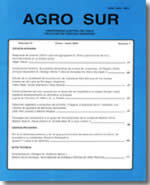Effect of four different water managements on strawberry yields in Valdivia, Chile
Main Article Content
Abstract
On a volcanic ash soil of Pelchuquin, 35 km north of Valdivia city, Chile, a field trial was carried out during the crop season 1995-96, in order to study the effect of four different hydric managements upon strawberry yields during its first year. A soil conditioner (hydrogel) was used in two different rates (100 and 50 g hydrogel/m2), compared to a drip irrigation treatment and to a control (natural growing condition), with the mean of measuring productivity parameters, such as: fruit yields and the number, weight, lenght and width of fruits. A completely randomized experimental design, with four treatments and three replications, was used. Results were submitted to anova and to the Tukey's test. Total applied water amount of the irrigation treatment was remarcably superior than those of the other treatments. During the period of highest water consumption (december, january and febuary), produced rainfall amounts were very low, presenting a situation of 34% rain deficiency. In relation to fruit yields, significant differences between irrigated treatment (4.350 kg/ha) and the rest of treatments, were found. Treatments with hydrogel did not show significant difference between each other (2.968 and 2.538 kg/ha, for 100 and 50 g hydrogel/m2, respectively), but they did show it with the control treatment (1.094 kg/ha). In none of the other analyzed parameters existed statistical differences between the treatments with 100 and 50 g of hydrogel/m2. The factor that produces the differences between fruit yields obtained by the treatment with irrigation and both with hydrogel, was the number of harvests made, which were 17 with irrigation, 11 using hydrogels and only 9 harvests with the treatment under natural condition (control).

